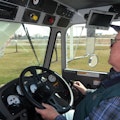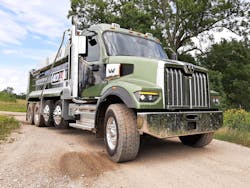Rock solid and carrying rocks. That’s the Western Star 47X you see here, though it was actually carrying gravel: about 30,000 pounds or 10 yards of it, a little light for a “quad” dumper common in Indiana and Wisconsin, among other states, but it made this test drive somewhat realistic. We were at the American Center for Mobility in Ypsilanti, Michigan, where I drove this 47X heavy-duty truck and other vehicles around a freeway-type paved track. The 400-acre facility includes streets and roads, some former municipal byways and others constructed since the place was established five years ago.
Staffers from Daimler Trucks North America were showing off the new 47X, the considerably improved successor to the popular Western Star 4700 vocational model, along with several other offerings from ‘Star and its sister brand, Freightliner. This dump truck was painted metallic green with geometric box- and triangle-graphics on a gloss black trapezoidal field that stretched back to the R/S Godwin dump body. Compared to the earlier 4700, the 47X’s styling is bolder, particularly the stainless steel grille, with its vertical bars canted inward at the top, where it meets the leading edge of the composite-material hood and the nameplate, a big W with a maroon star. The squinty LED headlamps give it a look of a big cat on the prowl.
See more: Inside the Western Star 47X
Under the hood was a stout Detroit DD13 Gen 5, this model’s standard diesel, rated at 440 horsepower and 1,650 lb.-ft. of torque, one of a dozen ratings available. Fifth-generation Detroits meet the federal EPA’s 2021 exhaust emission limits, which focus on reduced oxides of nitrogen—Nox—and did so with cleaner combustion and more efficient aftertreatment equipment. Those improvements are enough to allow use of a simple fixed-geometry turbocharger, which should be easy and economical to maintain and replace compared to variable-geometry turbos formerly used. Allison’s 4500 RDS torque-converter automatic transmission—increasingly popular in construction trucks—is standard with the DD13, but this truck had a toughened version of Detroit’s DT-12 automated manual transmission, which shifted smoothly and appropriately whether conditions were smooth or rough.
Less obvious at first glance is the steel-framed, aluminum-skinned cab, said to be 11 percent larger yet about 200 pounds lighter than the old annealed-steel cabin that dates to the mid-1990s. Reps called the new one the “Daimler cab,” for it is based on that of the Freightliner Cascadia road tractor, and it is shared with the previously introduced and slightly longer Western Star 49X, as well as a new 57X road tractor. Much of the cab’s greater size is in its girth; it’s now wide enough to house a crew of three, the helpers perched on a compact bench seat to the driver’s right. Our test truck had just two seats, one for me at the wheel and the other occupied by Greg Treinen, the vocational product marketing manager, who pointed out many of the 47X’s features. Among them were a factory-installed Bendix tire-pressure-monitoring system, Detroit Assurance 5.0 collision-mitigation system, and adaptive cruise control with adjustable headway (in seconds), set per the truck owner’s wishes.
The cab also has a new, attractive interior, including a two-piece instrument panel with new, easily read electromechanical gauges that replace the smallish round gauges found in the 4700 and other older models. Decent-size color screens can tell you more than you’ll probably ever need to know about what this truck is doing and put numbers to everything, not to mention displaying familiar warnings in words and ISO pictographs and of course audibles that call you out when you screw up. The new dash makes the entire info show more pleasant and, dare I say, entertaining. A new electrical wiring system allows body upfitters to plug right in and use switches on the dash’s B-panel to control, in this case, the dump bed’s functions. On this truck, however, a floor-mounted metal box with switches and a joy stick ran those things.
Treinen directed me to off-road dirt-and-gravel courses that tested the 47X’s frame, suspensions, cab integrity, and, for us, the truck’s ride quality. One course had tight turns, rises, and hollows while the other had deep furrows cut perpendicular to the direction of travel; both rigorously shook the truck and us, but we humans experienced more lateral lurching than vertical bashing, as taperleafs in front and the TufTrak rod- and block-type suspension over the tandem did a nice job of cushioning the terrain-induced shocks. Most of the trails were dry so the tires kicked up more dust than mud, and the money-green paint didn’t show much grime.
The DT-12 tranny did fine just left alone in D-for-Drive, chosen by a twist-collar on a stalk mounted on the steering column’s right side. But there’s also an M-for-Manual mode, and Treinen showed me how ratios could be chosen and held, how you can simulate popping the clutch to wrest the rear wheels from mud or sand, and how the transmission will upshift while the truck travels in R-for-Reverse. Fast reversing is useful where backing down a long, narrow pathway is required to reach a far-off load-placement point. It sure beats creeping along in a grandma gear and drumming one’s fingers on the steering wheel rim, because, as we all know, tedium is taxing and time is money. Yes, a good driver can upshift a manual crashbox into high range while reversing to gain some speed, but it’s worlds easier with an automated unit.
As I said up front, the 47X seems rock solid, from the slamming of its doors to banging over rough ground or cruising a freeway, yet it is rather easy on its driver. The roomier, well-trimmed cab is a nice place to work. It’s also versatile by way of component and equipment options, offering forward- and rear-set steer axles, even twin-steer axles, and axle placements to suit varying applications and weight laws. There’s also Cummins power if the standard DD13 is not what you want or need. Daimler, through Western Star and Freightliner, is the only major manufacturer that offers the lightweight Cummins X12 (Autocar, a low-volume builder, does, too); the lighter-weight L9 diesel can also be had for really low tare weight where that’s important. The three X series trucks and tractors now comprise Western Star lineup, as the 4800 and 6900 are being dropped, with their roles being absorbed by the new X models. Drive one and you might be compelled to acquire it.
Western Star 47X Test Set
- Truck: Western Star 47X 6x4 vocational chassis, w/ 0.51 X 3.43 X 12.24-in. steel frame rails, BBC 111.6 in., GVW 86,040 lb.
- Engine: Detroit DD13 Gen 5, 12.8 liters (781 cu.in.), EPA 2021 compliant, 470 hp @ 1,900 rpm/1,650 lb.-ft. @ 975 rpm
- Transmission: Detroit DT12-1650-OV Vocational 12-Speed
- Front Axle: 18,000-lb. Detroit DA-F-18.0-5 on 20,000-lb. taperleafs w/ Bendix dual hydraulic power steering
- Lift (pusher) axles: Two 13,500-lb. Hendrickson EX13 Composilite
- Rear Axle: 46,000-lb. Meritor RT-46-160P, w/ 3.42 ratio and driver-controlled locking differentials, on Daimler TufTrac Gen 2 mechanical suspension
- Wheelbase: 256 in.
- Front Tires: 385/65R22.5 Michelin XZY-3 18-ply
- Rear Tires: 11R22.5 Michelin X Multi D 16-ply
- Wheels: Alcoa polished aluminum discs
- Fuel, DEF tanks: 100-gal. aluminum, 8-gal. poly-plastic
- Body: 17-ft./18-cu.yd. R/S Godwin CS steel dump
About the Author

Tom Berg
Tom Berg is widely acknowleged as one of the top truck writers in the industry. He has covered construction for more than 34 years, and has test-driven well over 150 trucks for Construction Equipment.
